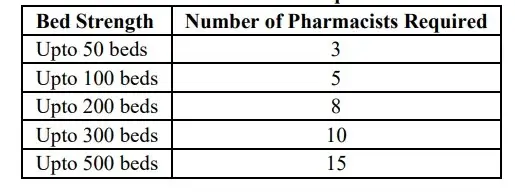At present, very few stock items are prepared on a spontaneous basis in hospitals. However, prepared or procured preparations are sent as floor stock medications, stored in the cabinets by the nursing staff, and administered to the patients as ordered by the physician. Further responsibilities of storage, maintenance, and records of administration are also fulfilled by the nursing staff.
Table of Contents
A modern hospital should take feedback from the nursing staff for the medical and pharmacy staff to make a drug information center. The nursing staff should spend considerable time visiting the pharmacy frequently to obtain the supplies. Many hospitals have a messenger service between these two. Generally, ward boys are employed to carry indent slips for regular and emergency supplies. If mechanization for the conveyance of drugs is not present, the best alternative is the floor stock system, which is selected by the clinical staff of the hospital.
Location, Layout, and Personnel
The inpatient department should be located on the ground floor or first floor of the building. It should be centrally located and also near the OPD so that the staff can easily reach there. The pharmacist along with skilled and qualified staff should carry out in-patient dispensing. When the -inpatients and outpatients receive services from a hospital, the hospital pharmacy should combine both departments. In-patient service should be near the medical departments (like maternity, orthopedic, etc.) and should be located such that it does not disturb the in-patient. In-patient pharmacy is a multi-functional department, which stores, dispenses, and also manufactures (IV fluids, parenteral, etc.).
Nowadays, satellite pharmacies are being operated either at the level of wards or based on the number of doors. These pharmacies need to be operated by a professional pharmacist.
The manpower trained in pharmacy varies with the hospital’s size and its services. The number of pharmacists required for a hospital depends on the workload norm like the number of prescriptions received and dispensed or the number of beds available in the hospital and their occupancy rate. Therefore, a minimum of 3 pharmacists should be present in a very small hospital; and 5 pharmacists should be present in a 100-bed hospital. The number of pharmacists increases with the number of beds. While calculating the number of pharmacists required in very large hospitals (with 1000 beds, 2000 beds, or 3000 beds), the service points available for dispensing to the inpatients and outpatients are considered.

The out-patient attendance as compared to bed strength in hospitals is in the ratio of 3:1. For larger hospitals, 133 patients are guided by one pharmacist.
Types of Services Provided to In-Patients
The following four systems of drug distribution to -patients are used in different hospitals in India:
- Individual prescription order system
- Floor ward stock system
- Combination of individual drug orders and floor stock system
- Unit dose dispensing system.
Individual Prescription Order System
Individual prescription order system, though old is still followed in small private hospitals. In this system, doctors write a prescription and ask the patient to get the medicines from licensed medical stores. Medications should be dispensed in properly labeled individual prescription containers. The amount of drug dispensed should be determined by the hospital policy.
Medication for administration should be labeled with:
- Patient’s name and location
- Drug’s name and strength
- Drug dose
- Administration route
- Accessory and cautionary statements
- Dispensed date
- Hospital’s name
Advantages
- Less number of staff is required in the hospital.
- Prescription is directly reviewed by the qualified pharmacist at the medical store.
- Doctors, pharmacists, and patients can interact well.
Disadvantages
- The chances for medication errors increase due to a lack of checks in the distribution of medication doses and also due to the inefficiencies in scheduling, preparing, administering, controlling, and recording during drug distribution and administration.
- Excessive nursing manpower is required while preparing medication doses and conducting other medication-related activities.
- The potential for drug loss due to waste, obsolescence, and deterioration also increases.
Floor Ward Stock System
The floor ward stock system is seen in private hospitals. In this system, the drugs are stored in the pharmacy stores, supplied to the wards when ordered, and supervised by a registered nurse at the nursing station.
There are two types of drugs:
- Charge Drugs: These are costly drugs obtained from the pharmacy store when the pharmacist receives the prescription for patients. The cost of drugs is billed to the patient’s account for charging.
- Non-Charge Drugs: These are cheaper and commonly used drugs. Their cost is not directly entered into the patient’s account but included in the per-day cost of the hospital ward.
Advantages
The floor ward stock system has the following advantages:
- The required drugs are delivered easily and quickly.
- The drug returns are eliminated.
- The number of pharmacy staff members required is reduced.
- The number of drug order transcriptions for the pharmacy is also reduced.
Disadvantages
The floor ward stock system has the following disadvantages:
- Drug interaction or adverse drug reactions can occur as the pharmacist does not review the prescription.
- Drug inventory on the pavilions is increased.
- To avoid drug deterioration, proper storage facilities are required inwards, and this increases the cost.
- There are greater chances for pilferage.
- There is a greater load upon the nurse’s time.
Combination of Individual Drug Orders and Floor Stock System
This medication distribution method is commonly used. The drugs in this method are mostly dispensed on an individual prescription basis; while the remaining drugs are obtained via limited floor stock. Included in the floor stock, are the frequently used drugs, i.e., analgesic controlled substances, non -prescription drugs (like Paracetamol), pre-operative anesthetic agents, and those not suited for individual prescription orders. In this system, nursing personnel prepare individual doses, reconstitute injectable medications, and order floor stock. The system has a disadvantage in that it lacks adequate checks of dosages prepared and the accuracy of charting of medication administration is less than desirable.
This system is followed in government and private hospitals running based on no profit and no loss. Individual prescription or medication system is mainly followed. Requirement of drugs or surgical items are given to the patient who purchases and deposits these items in hospital wards under the supervision of a registered nurse.
Unit Dose Dispensing System
Unit dose medications are ordered, packaged, administered, and charged in multiples of single dose units containing a predetermined amount of drug or supply sufficient dose for one regular dose, application, or use. This concept of unit dose dispensing is not new; single-dose disposable syringes of medications and single-unit foil or cellophane-wrapped capsules and tablets have been commercially available for many years. Unit dose dispensing is the pharmacist’s job, but in hospitals, it requires the cooperation of nursing, administrative, and medical staff. The hospital pharmacist educates the other staff members involved in unit dose dispensing about this system.
